Dora Carrington, the second of the two daughters and fourth of the five children of Samuel Carrington, railway engineer, and his wife, Charlotte Houghton, was born in Hereford on 29th March 1893. The family moved to Rothsay Gardens in Bedford
on 29th March 1893. The family moved to Rothsay Gardens in Bedford . She later recalled that she had "an awful childhood."
. She later recalled that she had "an awful childhood." 
According to Vanessa Curtis: "Although Carrington adored and revered her father, sketching him almost obsessively, she did not admire her fussy, martyr-like mother, who crammed the house with ornaments and devoted herself to charity work and religious causes." Her brother, Noel Carrington,
who crammed the house with ornaments and devoted herself to charity work and religious causes." Her brother, Noel Carrington, has suggested that his mother was obsessed with conformity and convention and this took two forms: "The first was extreme prudishness. Any mention of sex or the common bodily functions was unthinkable. We were not even expected to know that a woman was pregnant.
has suggested that his mother was obsessed with conformity and convention and this took two forms: "The first was extreme prudishness. Any mention of sex or the common bodily functions was unthinkable. We were not even expected to know that a woman was pregnant. Even a word like confined was kept to a whisper. The second was church-going and behaviour on Sunday. We all came to hate the whole atmosphere of a Sunday morning. The special clothes, the carrying of prayer books, the kneeling, standing and murmuring of litanies."
Even a word like confined was kept to a whisper. The second was church-going and behaviour on Sunday. We all came to hate the whole atmosphere of a Sunday morning. The special clothes, the carrying of prayer books, the kneeling, standing and murmuring of litanies." 
From her time at the Slade art school onwards she was commonly known simply by her surname. She was not well known as a painter during her lifetime, as she rarely exhibited and did not sign her work. She worked for a while at the Omega Workshops, and for the Hogarth Press, designing woodcuts
designing woodcuts 
Carrington was not a member of the Bloomsbury Group, though she was closely associated with Bloomsbury and, more generally, with "Bohemian" attitudes, through her long relationship with the homosexual writer Lytton Strachey , whom she first met in 1916. Distinguished by her cropped pageboy hair style (before it was fashionable) and somewhat androgynous appearance, she was troubled by her sexuality; she is known to have had at least two lesbian affairs (with Henrietta Bingham
, whom she first met in 1916. Distinguished by her cropped pageboy hair style (before it was fashionable) and somewhat androgynous appearance, she was troubled by her sexuality; she is known to have had at least two lesbian affairs (with Henrietta Bingham and Lady Ottoline Morrell)
and Lady Ottoline Morrell)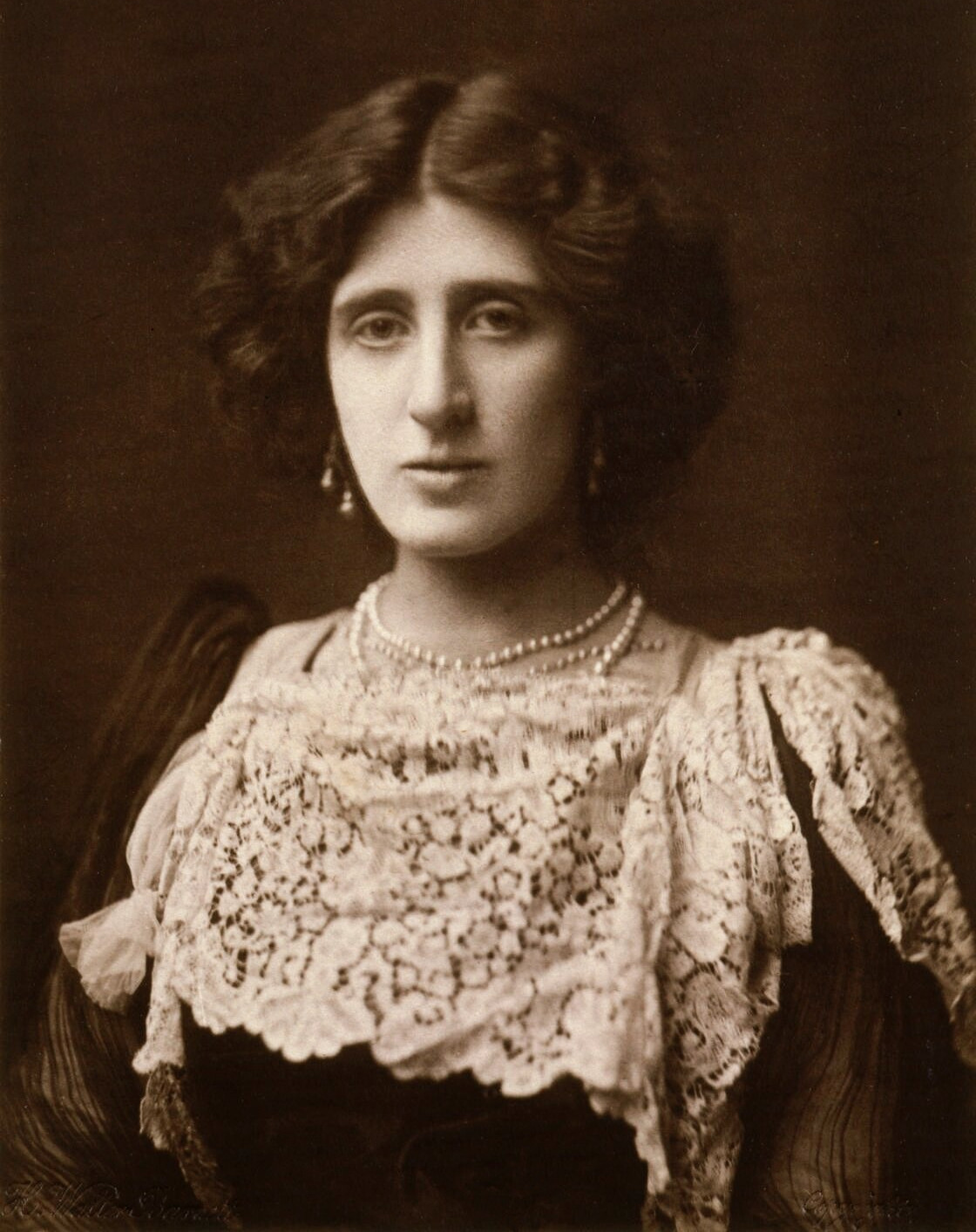 . She also had a significant relationship with the writer Gerald Brenan.
. She also had a significant relationship with the writer Gerald Brenan.
In June 1918 Virginia Woolf wrote of Carrington in her diary: "She is odd from her mixture of impulse & self consciousness.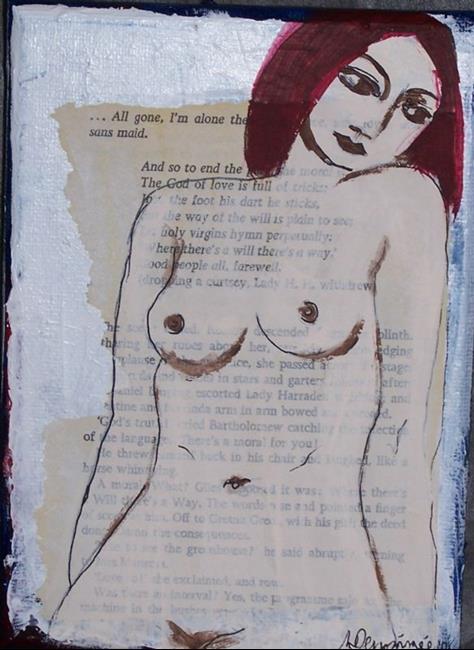 I wonder sometimes what she’s at: so eager to please, conciliatory, restless, & active. . . . [B]ut she is such a bustling eager creature, so red & solid, & at the same time inquisitive, that one can’t help liking her."Carrington first set up house with Lytton Strachey in November 1917, when they moved together to Tidmarsh Mill House,
I wonder sometimes what she’s at: so eager to please, conciliatory, restless, & active. . . . [B]ut she is such a bustling eager creature, so red & solid, & at the same time inquisitive, that one can’t help liking her."Carrington first set up house with Lytton Strachey in November 1917, when they moved together to Tidmarsh Mill House, near Pangbourne, Berkshire."
near Pangbourne, Berkshire."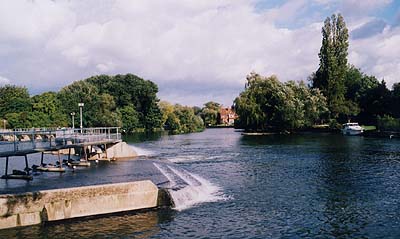 Sounds too good to be alright!" wrote Dora Carrington to Lytton Strachey on the morning of October 19 1917. She was poring over the particulars of The Mill at Tidmarsh in Berkshire. She added, in italics, that there was electric light and "bath H & C". After visiting, she reported it was romantic and lovely, and the rent was £52 a year for a three-year lease.
Sounds too good to be alright!" wrote Dora Carrington to Lytton Strachey on the morning of October 19 1917. She was poring over the particulars of The Mill at Tidmarsh in Berkshire. She added, in italics, that there was electric light and "bath H & C". After visiting, she reported it was romantic and lovely, and the rent was £52 a year for a three-year lease.
"Then I tried to do the same painting myself," says Bill, a retired commercial property developer. "I call my style primitive, but it is probably more primitive than hers." His version shows Tidmarsh Mill with a bright red swooping roof, its reflection ruddy in the water below, with a pair of swans silhouetted in the foreground.  Also hung in a corner of one of the mill's large sitting rooms is a pencil drawing by Carrington calledThe Men's Club. In cartoon style, it shows pillars of the establishment smoking cigars,
Also hung in a corner of one of the mill's large sitting rooms is a pencil drawing by Carrington calledThe Men's Club. In cartoon style, it shows pillars of the establishment smoking cigars,  puffing out their stomachs and looking down their long noses at each other in mutual congratulation.
puffing out their stomachs and looking down their long noses at each other in mutual congratulation.  Carrington (she dropped the forename) moved into the mill with Lytton just as he was publishingEminent Victorians, the book that made him famous.
Carrington (she dropped the forename) moved into the mill with Lytton just as he was publishingEminent Victorians, the book that made him famous.  The pair were already prominent in the Bloomsbury circle, which included Clive and Vanessa Bell, whose highly decorated house, Charleston in Sussex, is open to the public. Lytton and
The pair were already prominent in the Bloomsbury circle, which included Clive and Vanessa Bell, whose highly decorated house, Charleston in Sussex, is open to the public. Lytton and  Carrington were frequently seen at Lady Ottoline Morrell's parties at Garsington Manor. He was a spidery, bearded intellectual, widely known to be homosexual, she a Slade-trained artist with a pageboy haircut and no first name. Their decision to live together raised eyebrows inside and outside their group.Ralph Partridge
Carrington were frequently seen at Lady Ottoline Morrell's parties at Garsington Manor. He was a spidery, bearded intellectual, widely known to be homosexual, she a Slade-trained artist with a pageboy haircut and no first name. Their decision to live together raised eyebrows inside and outside their group.Ralph Partridge joined the household and eventually, in 1921, Carrington agreed to marry him, not for love but to hold the three-sided relationship together.
joined the household and eventually, in 1921, Carrington agreed to marry him, not for love but to hold the three-sided relationship together. 
The three moved to Ham Spray House in 1924, the home having been purchased by Strachey in the name of Partridge.
Strachey died of cancer at Ham Spray in January 1932. Carrington, who saw no purpose in a life without Strachey, committed suicide two months later by shooting herself with a gun borrowed from her friend, Hon. Bryan Guinness (later 2nd Baron Moyne). Her body was cremated and the ashes buried under the laurels in the garden of the Ham Spray House in Wiltshire.Carrington's life with Strachey was dramatized in the 1995 film Carrington, starring Emma Thompson in the title role.
An accomplished painter of both portraits and landscape, she also worked in applied and decorative arts, painting on any type of surface she had at hand including inn signs, tiles and furniture. She also decorated pottery. Carrington designed the library at Ham Spray.
Carrington designed the library at Ham Spray.
In 1970 David Garnett published a selection of letters and extracts from her diary, since which time critical and popular appreciation of her work has risen sharply. In 1978, Sir John Rothenstein, for nearly 30 years Director of the Tate Gallery, London, called Dora Carrington "the most neglected serious painter of her time." "That is no longer the case. In 1995, she was the subject of a major retrospective exhibition at the Barbican Art Gallery in London." Two of her works are in the Tate Gallery London
For many years, Carrington’s art was neglected by the public and her main notoriety was due to her relationship with Lytton Strachey. On the day she agreed to marry Partridge she wrote to Strachey, who was in Italy, what has been described as "one of the most moving love letters in the English language. She wrote "... I cried last night Lytton, whilst he slept by my side sleeping happily — I cried to think of a savage cynical fate which had made it impossible for my love ever to be used by you ...". Strachey wrote back "... you do know very well that I love you as something more than a friend, you angelic creature, whose goodness to me has made me happy for years, and whose presence in my life has been and always will be, one of the most important things in my life ...".
On the day she agreed to marry Partridge she wrote to Strachey, who was in Italy, what has been described as "one of the most moving love letters in the English language. She wrote "... I cried last night Lytton, whilst he slept by my side sleeping happily — I cried to think of a savage cynical fate which had made it impossible for my love ever to be used by you ...". Strachey wrote back "... you do know very well that I love you as something more than a friend, you angelic creature, whose goodness to me has made me happy for years, and whose presence in my life has been and always will be, one of the most important things in my life ...". On his deathbed, Strachey said, "I always wanted to marry Carrington and I never did." His biographer calls this sentiment "not true; but he could not have said anything more deeply consoling".Upon his death, Strachey left Carrington £10,000
On his deathbed, Strachey said, "I always wanted to marry Carrington and I never did." His biographer calls this sentiment "not true; but he could not have said anything more deeply consoling".Upon his death, Strachey left Carrington £10,000 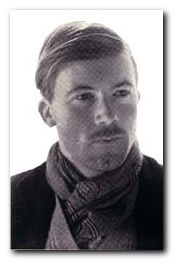 (the equivalent of £240,000 in 1994).
(the equivalent of £240,000 in 1994).

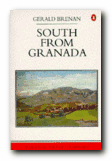 South from Granada is a classic in which Brenan describes setting up home in a remote Spanish village in the 1920s. He has a marvellous grasp of geography; he captures the rugged atmosphere of the region; and he has a particularly detailed knowledge of botany. Local characters and customs are vividly recounted. Bloomsbury enthusiasts will be delighted his by hilarious accounts of visits made by Lytton Strachey and Virginia Woolf under very difficult conditions, as well as a meeting with Roger Fry in Almeria.
South from Granada is a classic in which Brenan describes setting up home in a remote Spanish village in the 1920s. He has a marvellous grasp of geography; he captures the rugged atmosphere of the region; and he has a particularly detailed knowledge of botany. Local characters and customs are vividly recounted. Bloomsbury enthusiasts will be delighted his by hilarious accounts of visits made by Lytton Strachey and Virginia Woolf under very difficult conditions, as well as a meeting with Roger Fry in Almeria.
While at Bedford High School her teachers became aware of her artistic talent. Gretchen Gerzina, the author of A Life of Dora Carrington: 1893-1932 (1989) has pointed out: "At school, Dora's work was indifferent except in natural history and art, but her great talent for drawing and painting was obvious to everyone.... Her artistic success at Bedford High School was immense. Each year the Royal Drawing Society of Great Britain and Ireland awarded prizes for the best school drawings and exhibited them in a London show. Two years after entering the school, she became a regular winner: in 1905 she won First Class for imaginative drawings of figures; in 1906 a Bronze Star for figure drawing in colour."
In 1910 Samuel Carrington agreed that his daughter she should attend the Slade School. At the time the students included C.R.W. Nevinson , Mark Gertler, Stanley Spencer, John Currie
, Mark Gertler, Stanley Spencer, John Currie  , Maxwell Gordon Lightfoot
, Maxwell Gordon Lightfoot  , Dorothy Brett
, Dorothy Brett  , Paul Nash, John Nash
, Paul Nash, John Nash , David Bomberg, Isaac Rosenberg, Edward Wadsworth
, David Bomberg, Isaac Rosenberg, Edward Wadsworth  , Adrian Allinson
, Adrian Allinson  and Rudolph Ihlee
and Rudolph Ihlee  . Nevinson commented that the Slade "was full with a crowd of men such as I have never seen before or since." He also wrote that Gertler was "the genius of the place... and the most serious, single-minded artist I have ever come across." One of their tutors, Henry Tonks, who found them too rebellious, later pondered: "What a brood I have raised."
. Nevinson commented that the Slade "was full with a crowd of men such as I have never seen before or since." He also wrote that Gertler was "the genius of the place... and the most serious, single-minded artist I have ever come across." One of their tutors, Henry Tonks, who found them too rebellious, later pondered: "What a brood I have raised."
Carrington's friend, Frances Marshall, has argued: "She (Carrington) was an attractive and popular figure with her large blue eyes and her shock of thick hair bobbed in the fashion she had set... Moreover, her individual sense of fun and fantasy made her an enchanting companion, though a neurotic strain was also apparent.... Her oil paintings were much influenced by Mark Gertler in their careful, smooth technique, three-dimensioned effect, and dense, rich colour." Ottoline Morrell, who got to know her during this period, described her as "a wild moorland pony".
David Boyd Haycock , the author of A Crisis of Brilliance (2009) has pointed out that Carrington became very close to Dorothy
, the author of A Crisis of Brilliance (2009) has pointed out that Carrington became very close to Dorothy  Brett and Barbara Hiles while at the Slade School. Brett and Hiles copied Carrington when in 1911 she cut her long hair to a "short, boyish bob". They became known as the "Slade Cropheads" and "set a trend for young female art students".
Brett and Barbara Hiles while at the Slade School. Brett and Hiles copied Carrington when in 1911 she cut her long hair to a "short, boyish bob". They became known as the "Slade Cropheads" and "set a trend for young female art students".
While at Bedford High School Her artistic success at Bedford High School was immense. Each year the Royal Drawing Society of Great Britain and Ireland awarded prizes for the best school drawings and exhibited them in a London show. Two years after entering the school, she became a regular winner: in 1905 she won First Class for imaginative drawings of figures; in 1906 a Bronze Star for figure drawing in colour."
Her artistic success at Bedford High School was immense. Each year the Royal Drawing Society of Great Britain and Ireland awarded prizes for the best school drawings and exhibited them in a London show. Two years after entering the school, she became a regular winner: in 1905 she won First Class for imaginative drawings of figures; in 1906 a Bronze Star for figure drawing in colour."
Carrington's friend, Frances Marshall has argued: "She (Carrington) was an attractive and popular figure with her large blue eyes and her shock of thick hair bobbed in the fashion she had set... Moreover, her individual sense of fun and fantasy made her an enchanting companion, though a neurotic strain was also apparent.... Her oil paintings were much influenced by Mark Gertler in their careful, smooth technique, three-dimensioned effect, and dense, rich colour." Ottoline Morrell, who got to know her during this period, described her as "a wild moorland pony".
has argued: "She (Carrington) was an attractive and popular figure with her large blue eyes and her shock of thick hair bobbed in the fashion she had set... Moreover, her individual sense of fun and fantasy made her an enchanting companion, though a neurotic strain was also apparent.... Her oil paintings were much influenced by Mark Gertler in their careful, smooth technique, three-dimensioned effect, and dense, rich colour." Ottoline Morrell, who got to know her during this period, described her as "a wild moorland pony".
D
. Each year the Royal Drawing Society of Great Britain and Ireland awarded prizes for the best school drawings and exhibited them in a London show. Two years after entering the school, she became a regular winner: in 1905 she won First Class for imaginative drawings of figures; in 1906 a Bronze Star for figure drawing in colour."
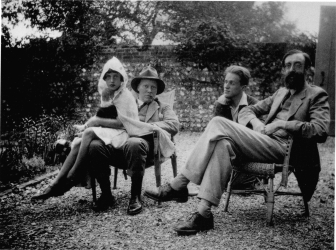 st as stated she attended the all-girls' Bedford High School which emphasized art. Her parents also paid for her to receive extra lessons in drawing.
st as stated she attended the all-girls' Bedford High School which emphasized art. Her parents also paid for her to receive extra lessons in drawing.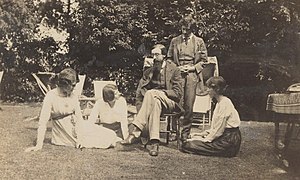 scholarship; there her fellow students included Paul Nash
scholarship; there her fellow students included Paul Nash , Christopher R. W. Nevinson and Mark Gertler. All at one time or another were in love with her, as was Nash's younger brother John Nash, who hoped to marry her. Gertler pursued Carrington for a number of years, and they had a brief sexual relationship during the years of the First World War. Paul Nash, a fellow student at the Slade School, later recalled: "Carrington... was the dominating
, Christopher R. W. Nevinson and Mark Gertler. All at one time or another were in love with her, as was Nash's younger brother John Nash, who hoped to marry her. Gertler pursued Carrington for a number of years, and they had a brief sexual relationship during the years of the First World War. Paul Nash, a fellow student at the Slade School, later recalled: "Carrington... was the dominating  personality, and when she cut her thick gold hair into a heavy golden bell, this, her fine blue eyes, her turned-in toes and other rather quaint but attractive attributes, combined to make her a conspicuous and popular figure...
personality, and when she cut her thick gold hair into a heavy golden bell, this, her fine blue eyes, her turned-in toes and other rather quaint but attractive attributes, combined to make her a conspicuous and popular figure...  I had noticed her long before this was achieved, when as a bored sufferer in the Antique Class my attention had been suddenly fixed by the sight of this amusing person with such very blue eyes and such incredibly thick pigtails of red-gold hair. I got an introduction to her and eventually won her regard by lending her my braces for a fancy-dress party. We were on the top of a bus and she wanted them then and there."
I had noticed her long before this was achieved, when as a bored sufferer in the Antique Class my attention had been suddenly fixed by the sight of this amusing person with such very blue eyes and such incredibly thick pigtails of red-gold hair. I got an introduction to her and eventually won her regard by lending her my braces for a fancy-dress party. We were on the top of a bus and she wanted them then and there." 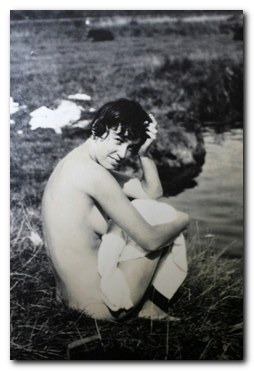 She formed a relation ship with Ralph Partridge, who was at that time married to Carrington, who in her turn happened to be in love with Lytton Strachey, with whom Carrington lived – though there is no open acknowledgement of the complex sexual relationships between the principals.Some of It is the story of a complex man and his world which it was felt could not be told while many of his friends and lovers were still alive. It is also a panorama of the social, literary, political and sexual life of a generation
She formed a relation ship with Ralph Partridge, who was at that time married to Carrington, who in her turn happened to be in love with Lytton Strachey, with whom Carrington lived – though there is no open acknowledgement of the complex sexual relationships between the principals.Some of It is the story of a complex man and his world which it was felt could not be told while many of his friends and lovers were still alive. It is also a panorama of the social, literary, political and sexual life of a generation 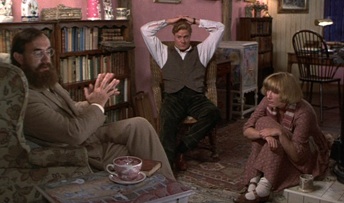 During World War I Lytton applied for recognition as a conscientious objector, but in the event was granted exemption from military service on health grounds. He spent much time with like-minded people such as Lady Ottoline Morrell and the 'Bloomsberries'. His first great success, and his most famous achievement, was Eminent Victorians (1918), a collection of four short biographies of Victorian heroes. This work was followed in the same style by Queen Victoria (1921). He died of (then undiagnosed) stomach cancer at age 51 at Ham Spray House, at Ham
During World War I Lytton applied for recognition as a conscientious objector, but in the event was granted exemption from military service on health grounds. He spent much time with like-minded people such as Lady Ottoline Morrell and the 'Bloomsberries'. His first great success, and his most famous achievement, was Eminent Victorians (1918), a collection of four short biographies of Victorian heroes. This work was followed in the same style by Queen Victoria (1921). He died of (then undiagnosed) stomach cancer at age 51 at Ham Spray House, at Ham  in WiltshireThough Strachey spoke openly about hishomosexuality with his Bloomsbury friends (he had a relationship with John Maynard Keynes,
in WiltshireThough Strachey spoke openly about hishomosexuality with his Bloomsbury friends (he had a relationship with John Maynard Keynes,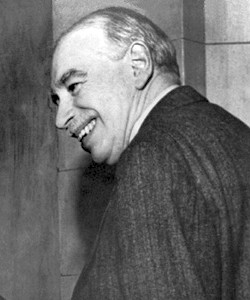 who also was part of the Bloomsbury group), it was not widely publicised until the late 1960s, in a biography by Michael Holroyd. He maintauined the unusual relationship with Carrington. . Strachey himself had been much more interested sexually in Partridge, as well as in various other young men.Strachey's letters, edited by Paul Levy, were published in 2005..
who also was part of the Bloomsbury group), it was not widely publicised until the late 1960s, in a biography by Michael Holroyd. He maintauined the unusual relationship with Carrington. . Strachey himself had been much more interested sexually in Partridge, as well as in various other young men.Strachey's letters, edited by Paul Levy, were published in 2005..
 on 29th March 1893. The family moved to Rothsay Gardens in Bedford
on 29th March 1893. The family moved to Rothsay Gardens in Bedford . She later recalled that she had "an awful childhood."
. She later recalled that she had "an awful childhood." 
According to Vanessa Curtis: "Although Carrington adored and revered her father, sketching him almost obsessively, she did not admire her fussy, martyr-like mother,
 who crammed the house with ornaments and devoted herself to charity work and religious causes." Her brother, Noel Carrington,
who crammed the house with ornaments and devoted herself to charity work and religious causes." Her brother, Noel Carrington, has suggested that his mother was obsessed with conformity and convention and this took two forms: "The first was extreme prudishness. Any mention of sex or the common bodily functions was unthinkable. We were not even expected to know that a woman was pregnant.
has suggested that his mother was obsessed with conformity and convention and this took two forms: "The first was extreme prudishness. Any mention of sex or the common bodily functions was unthinkable. We were not even expected to know that a woman was pregnant. Even a word like confined was kept to a whisper. The second was church-going and behaviour on Sunday. We all came to hate the whole atmosphere of a Sunday morning. The special clothes, the carrying of prayer books, the kneeling, standing and murmuring of litanies."
Even a word like confined was kept to a whisper. The second was church-going and behaviour on Sunday. We all came to hate the whole atmosphere of a Sunday morning. The special clothes, the carrying of prayer books, the kneeling, standing and murmuring of litanies." 
From her time at the Slade art school onwards she was commonly known simply by her surname. She was not well known as a painter during her lifetime, as she rarely exhibited and did not sign her work. She worked for a while at the Omega Workshops, and for the Hogarth Press,
 designing woodcuts
designing woodcuts 
Carrington was not a member of the Bloomsbury Group, though she was closely associated with Bloomsbury and, more generally, with "Bohemian" attitudes, through her long relationship with the homosexual writer Lytton Strachey
 , whom she first met in 1916. Distinguished by her cropped pageboy hair style (before it was fashionable) and somewhat androgynous appearance, she was troubled by her sexuality; she is known to have had at least two lesbian affairs (with Henrietta Bingham
, whom she first met in 1916. Distinguished by her cropped pageboy hair style (before it was fashionable) and somewhat androgynous appearance, she was troubled by her sexuality; she is known to have had at least two lesbian affairs (with Henrietta Bingham and Lady Ottoline Morrell)
and Lady Ottoline Morrell)
In June 1918 Virginia Woolf wrote of Carrington in her diary: "She is odd from her mixture of impulse & self consciousness.
 I wonder sometimes what she’s at: so eager to please, conciliatory, restless, & active. . . . [B]ut she is such a bustling eager creature, so red & solid, & at the same time inquisitive, that one can’t help liking her."Carrington first set up house with Lytton Strachey in November 1917, when they moved together to Tidmarsh Mill House,
I wonder sometimes what she’s at: so eager to please, conciliatory, restless, & active. . . . [B]ut she is such a bustling eager creature, so red & solid, & at the same time inquisitive, that one can’t help liking her."Carrington first set up house with Lytton Strachey in November 1917, when they moved together to Tidmarsh Mill House, near Pangbourne, Berkshire."
near Pangbourne, Berkshire." Sounds too good to be alright!" wrote Dora Carrington to Lytton Strachey on the morning of October 19 1917. She was poring over the particulars of The Mill at Tidmarsh in Berkshire. She added, in italics, that there was electric light and "bath H & C". After visiting, she reported it was romantic and lovely, and the rent was £52 a year for a three-year lease.
Sounds too good to be alright!" wrote Dora Carrington to Lytton Strachey on the morning of October 19 1917. She was poring over the particulars of The Mill at Tidmarsh in Berkshire. She added, in italics, that there was electric light and "bath H & C". After visiting, she reported it was romantic and lovely, and the rent was £52 a year for a three-year lease.
Today, The Mill, which became a setting for the tangled lives of the Bloomsbury set, is once more on the market, priced this time at £1.995 million. It will no doubt be viewed by well-heeled couples from the worlds of business and finance rather than rackety writers and artists. Today's buyers will be looking for something close enough to Pangbourne railway station  for an easy commute to London. But they will be touched in the same way by the magic of this spot on the River Pang, draped with ancient willows and blossoming cherry trees.
for an easy commute to London. But they will be touched in the same way by the magic of this spot on the River Pang, draped with ancient willows and blossoming cherry trees.

"We really didn't know very much about the Bloomsbury group when we moved in during the late Eighties," says the current owner, Bill Phelps.  "The previous owners mentioned it and I started to find out about them. I went to Bloomsbury and wandered about. While I was there I bought a book which had the famous picture on the front, painted by Carrington, of the mill itself."
"The previous owners mentioned it and I started to find out about them. I went to Bloomsbury and wandered about. While I was there I bought a book which had the famous picture on the front, painted by Carrington, of the mill itself."
 "The previous owners mentioned it and I started to find out about them. I went to Bloomsbury and wandered about. While I was there I bought a book which had the famous picture on the front, painted by Carrington, of the mill itself."
"The previous owners mentioned it and I started to find out about them. I went to Bloomsbury and wandered about. While I was there I bought a book which had the famous picture on the front, painted by Carrington, of the mill itself."
The book was Carrington: Letters and Extracts From Her Diary, edited by David Garnett. Published in 1970, it restored interest in her work to the extent that in 1978 Sir John Rothenstein, director of the Tate Gallery, called her "the most neglected serious painter of her time". She has since had a major retrospective at the Barbican and is now hung in the Tate.

 puffing out their stomachs and looking down their long noses at each other in mutual congratulation.
puffing out their stomachs and looking down their long noses at each other in mutual congratulation.  The pair were already prominent in the Bloomsbury circle, which included Clive and Vanessa Bell, whose highly decorated house, Charleston in Sussex, is open to the public. Lytton and
The pair were already prominent in the Bloomsbury circle, which included Clive and Vanessa Bell, whose highly decorated house, Charleston in Sussex, is open to the public. Lytton and  Carrington were frequently seen at Lady Ottoline Morrell's parties at Garsington Manor. He was a spidery, bearded intellectual, widely known to be homosexual, she a Slade-trained artist with a pageboy haircut and no first name. Their decision to live together raised eyebrows inside and outside their group.Ralph Partridge
Carrington were frequently seen at Lady Ottoline Morrell's parties at Garsington Manor. He was a spidery, bearded intellectual, widely known to be homosexual, she a Slade-trained artist with a pageboy haircut and no first name. Their decision to live together raised eyebrows inside and outside their group.Ralph Partridge joined the household and eventually, in 1921, Carrington agreed to marry him, not for love but to hold the three-sided relationship together.
joined the household and eventually, in 1921, Carrington agreed to marry him, not for love but to hold the three-sided relationship together. 
The three moved to Ham Spray House in 1924, the home having been purchased by Strachey in the name of Partridge.

Strachey died of cancer at Ham Spray in January 1932. Carrington, who saw no purpose in a life without Strachey, committed suicide two months later by shooting herself with a gun borrowed from her friend, Hon. Bryan Guinness (later 2nd Baron Moyne). Her body was cremated and the ashes buried under the laurels in the garden of the Ham Spray House in Wiltshire.Carrington's life with Strachey was dramatized in the 1995 film Carrington, starring Emma Thompson in the title role.

An accomplished painter of both portraits and landscape, she also worked in applied and decorative arts, painting on any type of surface she had at hand including inn signs, tiles and furniture. She also decorated pottery.
 Carrington designed the library at Ham Spray.
Carrington designed the library at Ham Spray.In 1970 David Garnett published a selection of letters and extracts from her diary, since which time critical and popular appreciation of her work has risen sharply. In 1978, Sir John Rothenstein, for nearly 30 years Director of the Tate Gallery, London, called Dora Carrington "the most neglected serious painter of her time." "That is no longer the case. In 1995, she was the subject of a major retrospective exhibition at the Barbican Art Gallery in London." Two of her works are in the Tate Gallery London

For many years, Carrington’s art was neglected by the public and her main notoriety was due to her relationship with Lytton Strachey.
 On the day she agreed to marry Partridge she wrote to Strachey, who was in Italy, what has been described as "one of the most moving love letters in the English language. She wrote "... I cried last night Lytton, whilst he slept by my side sleeping happily — I cried to think of a savage cynical fate which had made it impossible for my love ever to be used by you ...". Strachey wrote back "... you do know very well that I love you as something more than a friend, you angelic creature, whose goodness to me has made me happy for years, and whose presence in my life has been and always will be, one of the most important things in my life ...".
On the day she agreed to marry Partridge she wrote to Strachey, who was in Italy, what has been described as "one of the most moving love letters in the English language. She wrote "... I cried last night Lytton, whilst he slept by my side sleeping happily — I cried to think of a savage cynical fate which had made it impossible for my love ever to be used by you ...". Strachey wrote back "... you do know very well that I love you as something more than a friend, you angelic creature, whose goodness to me has made me happy for years, and whose presence in my life has been and always will be, one of the most important things in my life ...". On his deathbed, Strachey said, "I always wanted to marry Carrington and I never did." His biographer calls this sentiment "not true; but he could not have said anything more deeply consoling".Upon his death, Strachey left Carrington £10,000
On his deathbed, Strachey said, "I always wanted to marry Carrington and I never did." His biographer calls this sentiment "not true; but he could not have said anything more deeply consoling".Upon his death, Strachey left Carrington £10,000  (the equivalent of £240,000 in 1994).
(the equivalent of £240,000 in 1994).

 South from Granada is a classic in which Brenan describes setting up home in a remote Spanish village in the 1920s. He has a marvellous grasp of geography; he captures the rugged atmosphere of the region; and he has a particularly detailed knowledge of botany. Local characters and customs are vividly recounted. Bloomsbury enthusiasts will be delighted his by hilarious accounts of visits made by Lytton Strachey and Virginia Woolf under very difficult conditions, as well as a meeting with Roger Fry in Almeria.
South from Granada is a classic in which Brenan describes setting up home in a remote Spanish village in the 1920s. He has a marvellous grasp of geography; he captures the rugged atmosphere of the region; and he has a particularly detailed knowledge of botany. Local characters and customs are vividly recounted. Bloomsbury enthusiasts will be delighted his by hilarious accounts of visits made by Lytton Strachey and Virginia Woolf under very difficult conditions, as well as a meeting with Roger Fry in Almeria.
While at Bedford High School her teachers became aware of her artistic talent. Gretchen Gerzina, the author of A Life of Dora Carrington: 1893-1932 (1989) has pointed out: "At school, Dora's work was indifferent except in natural history and art, but her great talent for drawing and painting was obvious to everyone.... Her artistic success at Bedford High School was immense. Each year the Royal Drawing Society of Great Britain and Ireland awarded prizes for the best school drawings and exhibited them in a London show. Two years after entering the school, she became a regular winner: in 1905 she won First Class for imaginative drawings of figures; in 1906 a Bronze Star for figure drawing in colour."
In 1910 Samuel Carrington agreed that his daughter she should attend the Slade School. At the time the students included C.R.W. Nevinson
 , Mark Gertler, Stanley Spencer, John Currie
, Mark Gertler, Stanley Spencer, John Currie  , Maxwell Gordon Lightfoot
, Maxwell Gordon Lightfoot  , Dorothy Brett
, Dorothy Brett  , Paul Nash, John Nash
, Paul Nash, John Nash , David Bomberg, Isaac Rosenberg, Edward Wadsworth
, David Bomberg, Isaac Rosenberg, Edward Wadsworth  , Adrian Allinson
, Adrian Allinson  and Rudolph Ihlee
and Rudolph Ihlee  . Nevinson commented that the Slade "was full with a crowd of men such as I have never seen before or since." He also wrote that Gertler was "the genius of the place... and the most serious, single-minded artist I have ever come across." One of their tutors, Henry Tonks, who found them too rebellious, later pondered: "What a brood I have raised."
. Nevinson commented that the Slade "was full with a crowd of men such as I have never seen before or since." He also wrote that Gertler was "the genius of the place... and the most serious, single-minded artist I have ever come across." One of their tutors, Henry Tonks, who found them too rebellious, later pondered: "What a brood I have raised."Carrington's friend, Frances Marshall, has argued: "She (Carrington) was an attractive and popular figure with her large blue eyes and her shock of thick hair bobbed in the fashion she had set... Moreover, her individual sense of fun and fantasy made her an enchanting companion, though a neurotic strain was also apparent.... Her oil paintings were much influenced by Mark Gertler in their careful, smooth technique, three-dimensioned effect, and dense, rich colour." Ottoline Morrell, who got to know her during this period, described her as "a wild moorland pony".
David Boyd Haycock
 , the author of A Crisis of Brilliance (2009) has pointed out that Carrington became very close to Dorothy
, the author of A Crisis of Brilliance (2009) has pointed out that Carrington became very close to Dorothy  Brett and Barbara Hiles while at the Slade School. Brett and Hiles copied Carrington when in 1911 she cut her long hair to a "short, boyish bob". They became known as the "Slade Cropheads" and "set a trend for young female art students".
Brett and Barbara Hiles while at the Slade School. Brett and Hiles copied Carrington when in 1911 she cut her long hair to a "short, boyish bob". They became known as the "Slade Cropheads" and "set a trend for young female art students". While at Bedford High School
 Her artistic success at Bedford High School was immense. Each year the Royal Drawing Society of Great Britain and Ireland awarded prizes for the best school drawings and exhibited them in a London show. Two years after entering the school, she became a regular winner: in 1905 she won First Class for imaginative drawings of figures; in 1906 a Bronze Star for figure drawing in colour."
Her artistic success at Bedford High School was immense. Each year the Royal Drawing Society of Great Britain and Ireland awarded prizes for the best school drawings and exhibited them in a London show. Two years after entering the school, she became a regular winner: in 1905 she won First Class for imaginative drawings of figures; in 1906 a Bronze Star for figure drawing in colour." Carrington's friend, Frances Marshall
 has argued: "She (Carrington) was an attractive and popular figure with her large blue eyes and her shock of thick hair bobbed in the fashion she had set... Moreover, her individual sense of fun and fantasy made her an enchanting companion, though a neurotic strain was also apparent.... Her oil paintings were much influenced by Mark Gertler in their careful, smooth technique, three-dimensioned effect, and dense, rich colour." Ottoline Morrell, who got to know her during this period, described her as "a wild moorland pony".
has argued: "She (Carrington) was an attractive and popular figure with her large blue eyes and her shock of thick hair bobbed in the fashion she had set... Moreover, her individual sense of fun and fantasy made her an enchanting companion, though a neurotic strain was also apparent.... Her oil paintings were much influenced by Mark Gertler in their careful, smooth technique, three-dimensioned effect, and dense, rich colour." Ottoline Morrell, who got to know her during this period, described her as "a wild moorland pony".D
. Each year the Royal Drawing Society of Great Britain and Ireland awarded prizes for the best school drawings and exhibited them in a London show. Two years after entering the school, she became a regular winner: in 1905 she won First Class for imaginative drawings of figures; in 1906 a Bronze Star for figure drawing in colour."

 st as stated she attended the all-girls' Bedford High School which emphasized art. Her parents also paid for her to receive extra lessons in drawing.
st as stated she attended the all-girls' Bedford High School which emphasized art. Her parents also paid for her to receive extra lessons in drawing. scholarship; there her fellow students included Paul Nash
scholarship; there her fellow students included Paul Nash , Christopher R. W. Nevinson and Mark Gertler. All at one time or another were in love with her, as was Nash's younger brother John Nash, who hoped to marry her. Gertler pursued Carrington for a number of years, and they had a brief sexual relationship during the years of the First World War. Paul Nash, a fellow student at the Slade School, later recalled: "Carrington... was the dominating
, Christopher R. W. Nevinson and Mark Gertler. All at one time or another were in love with her, as was Nash's younger brother John Nash, who hoped to marry her. Gertler pursued Carrington for a number of years, and they had a brief sexual relationship during the years of the First World War. Paul Nash, a fellow student at the Slade School, later recalled: "Carrington... was the dominating  personality, and when she cut her thick gold hair into a heavy golden bell, this, her fine blue eyes, her turned-in toes and other rather quaint but attractive attributes, combined to make her a conspicuous and popular figure...
personality, and when she cut her thick gold hair into a heavy golden bell, this, her fine blue eyes, her turned-in toes and other rather quaint but attractive attributes, combined to make her a conspicuous and popular figure...  I had noticed her long before this was achieved, when as a bored sufferer in the Antique Class my attention had been suddenly fixed by the sight of this amusing person with such very blue eyes and such incredibly thick pigtails of red-gold hair. I got an introduction to her and eventually won her regard by lending her my braces for a fancy-dress party. We were on the top of a bus and she wanted them then and there."
I had noticed her long before this was achieved, when as a bored sufferer in the Antique Class my attention had been suddenly fixed by the sight of this amusing person with such very blue eyes and such incredibly thick pigtails of red-gold hair. I got an introduction to her and eventually won her regard by lending her my braces for a fancy-dress party. We were on the top of a bus and she wanted them then and there."  She formed a relation ship with Ralph Partridge, who was at that time married to Carrington, who in her turn happened to be in love with Lytton Strachey, with whom Carrington lived – though there is no open acknowledgement of the complex sexual relationships between the principals.Some of It is the story of a complex man and his world which it was felt could not be told while many of his friends and lovers were still alive. It is also a panorama of the social, literary, political and sexual life of a generation
She formed a relation ship with Ralph Partridge, who was at that time married to Carrington, who in her turn happened to be in love with Lytton Strachey, with whom Carrington lived – though there is no open acknowledgement of the complex sexual relationships between the principals.Some of It is the story of a complex man and his world which it was felt could not be told while many of his friends and lovers were still alive. It is also a panorama of the social, literary, political and sexual life of a generation  During World War I Lytton applied for recognition as a conscientious objector, but in the event was granted exemption from military service on health grounds. He spent much time with like-minded people such as Lady Ottoline Morrell and the 'Bloomsberries'. His first great success, and his most famous achievement, was Eminent Victorians (1918), a collection of four short biographies of Victorian heroes. This work was followed in the same style by Queen Victoria (1921). He died of (then undiagnosed) stomach cancer at age 51 at Ham Spray House, at Ham
During World War I Lytton applied for recognition as a conscientious objector, but in the event was granted exemption from military service on health grounds. He spent much time with like-minded people such as Lady Ottoline Morrell and the 'Bloomsberries'. His first great success, and his most famous achievement, was Eminent Victorians (1918), a collection of four short biographies of Victorian heroes. This work was followed in the same style by Queen Victoria (1921). He died of (then undiagnosed) stomach cancer at age 51 at Ham Spray House, at Ham  who also was part of the Bloomsbury group), it was not widely publicised until the late 1960s, in a biography by Michael Holroyd. He maintauined the unusual relationship with Carrington. . Strachey himself had been much more interested sexually in Partridge, as well as in various other young men.Strachey's letters, edited by Paul Levy, were published in 2005..
who also was part of the Bloomsbury group), it was not widely publicised until the late 1960s, in a biography by Michael Holroyd. He maintauined the unusual relationship with Carrington. . Strachey himself had been much more interested sexually in Partridge, as well as in various other young men.Strachey's letters, edited by Paul Levy, were published in 2005..
No comments:
Post a Comment